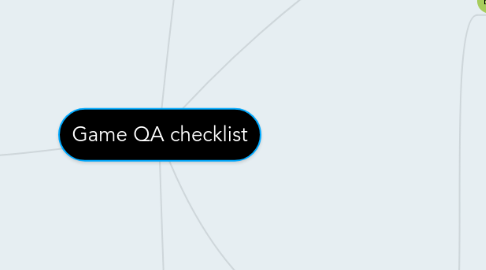
1. Visuals
1.1. Introduction Screen
1.1.1. Studio animation (5 seconds)
1.1.2. Skip studio animation button
1.1.2.1. Neutral
1.1.2.2. Mouse over
1.2. Title Screen
1.2.1. Enter / Exit screen transition animation
1.2.2. Game Logo graphics
1.2.3. Start Game Button / Options Button / Credits Button / Quit Game Button
1.2.3.1. Neutral
1.2.3.2. Mouse over
1.2.3.3. Hit & animation
1.2.4. Copyright Statement
1.2.5. Background Graphics
1.3. Credits Screen
1.3.1. Enter / Exit screen transition animation
1.3.2. Names and roles display
1.3.3. Source credit display
1.3.4. Back button
1.3.4.1. neutral
1.3.4.2. mouse over
1.3.4.3. hit & animation
1.3.5. background graphics
1.4. Gameplay Screen
1.4.1. Non-diegetic UI
1.4.1.1. HP/Skill/MP bar/icons
1.4.1.1.1. bar / Icons
1.4.1.1.2. Feedback animation
1.4.1.2. Switch skill icons
1.4.1.3. Score display
1.4.1.4. Money/Credits/Currency display & icon
1.4.1.5. Collectables
1.4.1.5.1. Display and/or Icon
1.4.1.5.2. Obtain feedback animation
1.4.2. Spatial UI
1.4.2.1. Damage number display & animation
1.4.2.1.1. Character
1.4.2.1.2. Enemy
1.4.2.2. Character emotion icons
1.5. In Game
1.5.1. General
1.5.1.1. Character asset
1.5.1.1.1. state(s) & animation(s)
1.5.1.1.2. Special effects
1.5.1.1.3. Invincibility animation
1.5.1.1.4. Collectables
1.5.2. Levels
1.5.2.1. General
1.5.2.1.1. asset(s)
1.5.2.1.2. Special effects
1.5.2.1.3. Graphics
1.5.2.2. Non-diegetic UI
1.5.2.2.1. Level One / Tutorial Level
1.5.2.2.2. Levels 2 & 3
1.6. Pause screen UI
1.6.1. darken screen
1.6.2. pause caption
1.6.3. instructions to unpause
1.7. Game Over / Victory Screen
1.7.1. General
1.7.1.1. Screen transition animation
1.7.1.1.1. Enter
1.7.1.1.2. Exit
1.7.1.2. Background Graphics
1.7.2. Buttons
1.7.2.1. State and/or animations
1.7.2.1.1. General
1.7.2.1.2. victory
1.7.3. Captions
1.7.3.1. Victory
1.7.3.2. Game Over
1.7.4. Victory Screen Only
1.7.4.1. Score display
1.7.4.2. Collectables display and icon
2. Sound
2.1. BGM
2.1.1. Title screen
2.1.2. Credits screen
2.1.3. Levels 1-3
2.1.4. Game Over screen (single loop)
2.1.5. Victory Screen
2.2. Sound Effects
2.2.1. Buttons
2.2.1.1. Mouse over and/or hit
2.2.1.1.1. Title Screen
2.2.1.1.2. Credits Screen
2.2.1.1.3. Options Screen
2.2.1.1.4. Game Over / Victory Screen
2.2.2. General
2.2.2.1. Character
2.2.2.1.1. Attack
2.2.2.1.2. attack hits enemy(s)
2.2.2.1.3. Pickup Collectables
2.2.2.1.4. Heals
2.2.3. Levels 1-3
2.2.3.1. Enemy
2.2.3.1.1. attack
2.2.3.1.2. attack(s) hit character
3. Usability
3.1. Introduction Screen
3.1.1. Logo contrast well with background
3.2. Title screen
3.2.1. Logo
3.2.1.1. Contrasts well with background
3.2.1.2. position at point of focus (Rule of thirds)
3.2.1.3. Size at least 1/4 of screen
3.2.2. Buttons clearly visible
3.3. Credits
3.3.1. Back Button
3.3.1.1. Clearly visible
3.3.1.2. placed at Bottom right/left of screen
3.4. Gameplay
3.4.1. Contrasts well with background
3.4.1.1. HP/MP/Skill bars/icons
3.4.1.2. Switch skill icons
3.4.1.3. Score display
3.4.1.4. Money/credits/currency
3.4.1.5. collectables
3.4.1.6. damage number
3.4.2. Sizes
3.4.2.1. HP/MP/Skill bar
3.4.2.1.1. Height 1/5 of screen
3.4.2.1.2. Width 1/3 of screen
3.4.3. UI Layout
3.4.3.1. Golden ratio / rule of thirds
3.4.3.2. consideration to user reading order
3.5. In Game
3.5.1. General
3.5.1.1. Character
3.5.1.1.1. centralised in the middle column
3.5.1.1.2. positioned in the lower line in rules of third
3.5.1.1.3. Invincibility lasts 3 seconds
3.5.1.2. Sufficient space for players to see enemies or obstacles from either side
3.5.2. Levels
3.5.2.1. General
3.5.2.1.1. 2 types of font or less
3.5.2.1.2. position of instructions are eye catching and do not obstruct gameplay
3.5.2.1.3. Objective instructions contrasts well from all background types
3.5.2.2. Contrasts well with all background types
3.5.2.2.1. Level One / Tutorial Level
3.5.2.2.2. Level 2 &3
3.6. Pause screen
3.6.1. Clearly Visible and contrasts well from background
3.6.1.1. Pause caption
3.6.1.2. instructions
3.6.2. Pause caption
3.6.2.1. Size is 1/6 of screen
3.6.2.2. positioned at point of focus (rule of thirds)
3.7. Game Over / Victory screen
3.7.1. General
3.7.1.1. Clearly visible buttons
3.7.1.2. Caption (Victory/Game Over)
3.7.1.2.1. Contrasts well from background
3.7.1.2.2. positioned at point of focus (rule of thirds)
3.7.1.2.3. size is 1/5 of screen
3.7.2. Victory Screen only
3.7.2.1. Contrasts well from background
3.7.2.1.1. Score display
3.7.2.1.2. Collectables display & icon
4. Functionality
4.1. Introduction Screen
4.1.1. Skip studio animation button
4.2. Title Screen
4.2.1. Start Game button
4.2.2. Options Button
4.2.3. Credits Button
4.2.4. Quit game button
4.3. Credits Screen
4.3.1. Back Button
4.4. Gameplay Screen
4.4.1. HP/MP/Skill bar/Icon will increase/decrease with gameplay
4.4.2. Skill Icons can be switched or toggled
4.4.3. Score display updates with gameplay
4.4.4. Money/credits/currency display updates with gameplay
4.4.5. Collectables display updates with gameplay
4.5. In Game
4.5.1. General
4.5.1.1. Character HP decreases according to damage figure when hit/fall/event
4.5.1.2. Movement and actions correspond to correct key presses
4.5.2. Level One/ Tutorial Level to Level 3
4.5.2.1. Background Layer 1 & 2 scrolling
4.5.2.2. Gameplay level
4.5.2.2.1. Platform scrolling
4.5.2.2.2. Ground Scrolling
4.5.2.3. Enemy A.I.
4.5.2.3.1. Movement
4.5.2.3.2. Attack
4.5.2.3.3. Action
4.6. Pause Screen
4.6.1. Unpause key/button
4.7. Game Over Screen
4.7.1. Restart level button
4.7.2. Back to title button
4.8. Victory Screen
4.8.1. Back to title button
4.8.2. Restart Level
5. Design
5.1. In Game
5.1.1. General
5.1.1.1. Level 1-3
5.1.1.1.1. Layouts
5.1.1.1.2. Placements
5.1.1.1.3. Progressive Difficulty
5.1.1.1.4. Placement Balance
5.1.1.1.5. Introduction to new/extended mechanics
5.1.1.1.6. Theme Consistency
